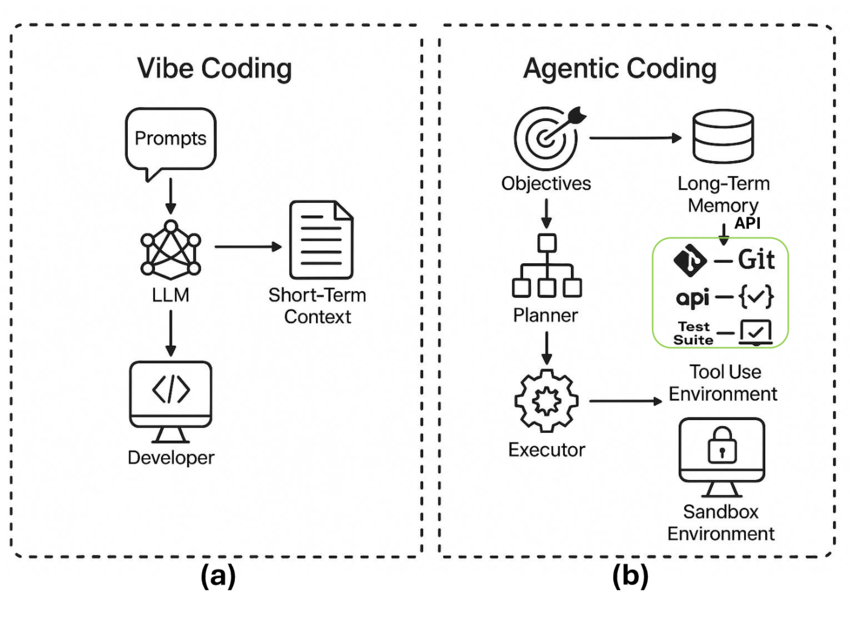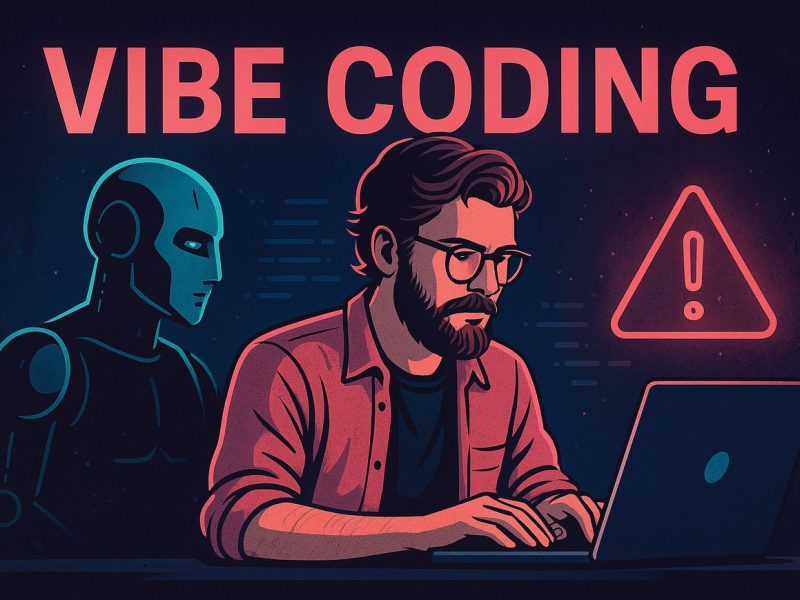Decoding the Future of AI-Assisted Development
Introduction
The advent of Large Language Models (LLMs) has catalyzed two distinct paradigms in AI-driven software development: Vibe Coding and Agentic Coding. While both leverage generative AI, their architectures, workflows, and philosophical underpinnings diverge significantly. Vibe Coding prioritizes human intuition and rapid iteration, whereas Agentic Coding emphasizes autonomous, goal-oriented execution. This post dissects their architectures, tools, and real-world implications, drawing on industry frameworks and emerging research.
1. Vibe Coding: The Human-AI Collaboration Model
Architecture Overview
Vibe Coding centers on developer-led prompting within familiar environments like IDEs (e.g., VS Code) or web interfaces. Its architecture relies on three pillars:
LLM: The model (e.g., GPT-4, Claude 3) generates code based on prompts.
Short-Term Context: Limited to the current session or file (typically 4K–128K tokens).
Developer: Acts as the “conductor,” manually executing, testing, and integrating outputs.
Workflow Dynamics
Prompt Crafting: Developers describe intent (e.g., “Create a React form with validation”).
LLM Response: The model generates code snippets.
Manual Integration: Developers test, debug, and merge code into the codebase.
Iteration: Short feedback loops refine prompts based on errors or edge cases.
Strengths and Limitations
✅ Pros:
Low barrier to entry; ideal for prototyping, boilerplate, or documentation.
Preserves developer control over design decisions.
❌ Cons:
Context window constraints hinder complex tasks.
No memory or autonomous tool use; reliant on human oversight.
Tools & Frameworks
GitHub Copilot: Deep IDE integration for real-time suggestions. GitHub Copilot
Replit Ghostwriter: Cloud-based LLM pair programmer. Replit
Tabnine: Local model options for privacy-focused teams. Tabnine
2. Agentic Coding: The Autonomous AI Engineer
Architecture Overview
Agentic Coding treats AI as an autonomous agent capable of multi-step problem-solving. Its modular architecture includes:
Objectives: High-level goals (e.g., “Build a REST API for user management”).
Planner: Breaks objectives into subtasks (e.g., “1. Setup auth, 2. Design endpoints”).
Executor: Runs code, calls APIs, and manipulates files.
Long-Term Memory API: Stores context across sessions (e.g., vector databases).
Tool Use Environment: Interfaces with Git, test suites, or cloud APIs.
Sandbox Environment: Isolated execution (e.g., Docker, WebAssembly).
Workflow Dynamics
Objective Definition: Developer specifies a goal.
Planning & Execution:
The planner decomposes tasks.
The executor runs code, commits via Git API, and validates tests.
Self-Correction: Agents use memory to learn from past errors.
Output Delivery: Final code, logs, and artifacts are returned.
Strengths and Limitations
✅ Pros:
Handles complex, multi-step tasks (e.g., refactoring legacy systems).
Reduces human toil through automation.
❌ Cons:
Risk of “hallucinated” solutions without guardrails.
Higher infrastructure complexity.
Tools & Frameworks
LangChain: For building agentic workflows with memory. LangChain
AutoGen: Microsoft’s multi-agent framework. AutoGen
OpenAI Assistants API: Tool-augmented agents with retrieval. OpenAI
Cognition Labs Devin: Fully autonomous AI software engineer. Devin
3. Comparative Analysis: Vibe vs. Agentic
(a) Context Handling
Vibe Coding:
Short-term context limits sophistication. Example: An LLM can generate a single function but struggles to refactor an entire module.Agentic Coding:
Long-term memory (e.g., ChromaDB, Pinecone) enables cross-session coherence. Agents recall prior decisions, reducing redundant work.
(b) Tool Integration
Vibe Coding:
Tools (e.g., linters, tests) are manually executed.Agentic Coding:
Agents invoke tools autonomously:Git API for version control.
pytest/Jest for test automation.
Sandboxed environments for safe execution.
(c) Error Resolution
Vibe Coding:
Developers debug iteratively via prompt tuning.Agentic Coding:
Self-correcting loops: Failed tests trigger re-planning.
(d) Scalability
Vibe Coding: Best for small teams or greenfield projects.
Agentic Coding: Scales to enterprise tasks (e.g., migrating codebases).
4. Use Cases: Where Each Excels
| Scenario | Vibe Coding | Agentic Coding |
|---|---|---|
| Prototyping | ✅ Ideal (fast) | ⚠️ Overkill |
| Debugging Legacy Code | ⚠️ Limited context | ✅ Autonomous tracing |
| CI/CD Automation | ❌ Manual | ✅ Git + Test Suite API |
| Documentation | ✅ High accuracy | ❌ Redundant |
5. The Future: Convergence and Challenges
Emerging Hybrid Models
Tools like GPT Engineer (hybrid of both) and GitHub Copilot Workspace (prompt-to-agent escalation) signal convergence. GPT Engineer
Ethical & Technical Challenges
Vibe Coding: Attribution of AI-generated code (legal implications).
Agentic Coding:
Sandbox security vulnerabilities (CVE-2024-21626).
Unpredictable tool chaining (e.g., accidental resource deletion).
Research Frontiers
Vibe Coding: Context window expansion (e.g., Gemini 1M tokens).
Agentic Coding:
Self-improving agents (Stanford’s “Self-Operating Computer”). Paper
Formal verification for agent actions (Microsoft Research).
6. Conclusion
Vibe Coding democratizes AI assistance, augmenting developers’ creativity without disrupting workflows. Agentic Coding, however, is poised to revolutionize software engineering by automating entire pipelines—akin to an “AI workforce.” While Vibe suits daily coding, Agentic shines in systematic, tool-heavy environments.
The Verdict:
Adopt Vibe Coding for:
Learning, prototyping, and pair programming.
Deploy Agentic Coding for:
Legacy modernization, CI/CD, and large-scale refactoring.
As frameworks mature, the fusion of both paradigms will define next-gen development. Start experimenting with LangChain or Copilot today—but always keep humans in the loop.
References & Tools Recap
Vibe Coding Tools
GitHub Copilot: https://github.com/features/copilot
Replit Ghostwriter: https://replit.com/site/ghostwriter
Codeium: https://codeium.com
Agentic Coding Frameworks
LangChain: https://python.langchain.com
AutoGen: https://microsoft.github.io/autogen
OpenAI Assistants API: https://platform.openai.com/docs/assistants
Research
LLM Tool Use: arXiv:2305.18223
Agentic Workflow Risks: arXiv:2402.02705
Self-Improving Agents: Stanford CRFM
Final Word: The future isn’t Vibe vs. Agentic—it’s about choosing the right AI “colleague” for the task. Stay curious, stay critical.


